Pulmonary veno-occlusive disease (PVOD) is a very rare disorder of the small veins in the lungs. The incidence and prevalence of PVOD is not well characterized. There are rare families that have been described where multiple family members have been affected by the disease. This suggests a possible genetic contribution in some circumstances. However, in general the disease has no clear cause identified. Some cases are associated with connective tissue disease such as scleroderma or lupus.
Symptoms of PVOD
The symptoms of PVOD are identical to pulmonary arterial hypertension. Patients experience progressive shortness of breath, exercise intolerance and swelling of the ankles (edema).
Testing for Pulmonary Veno-Occlusive Disease
 The echocardiogram in PVOD looks identical to PAH. The right side of the heart is enlarged and over time the function of the right ventricle declines. The left side of the heart remains normal. The right heart catheterization shares many features with pulmonary arterial hypertension and in general is not able to reliably differentiate the two diseases. Ventilation-perfusion scanning of the lungs may be mildly abnormal or may mimic PAH or chronic blood clot disease. Computed Tomography (CT scans) of the lungs may show a characteristic pattern of abnormality. Pulmonary functions tests in PVOD are indistinguishable from PAH. There are no laboratory tests that are helpful in diagnosing PVOD.
The echocardiogram in PVOD looks identical to PAH. The right side of the heart is enlarged and over time the function of the right ventricle declines. The left side of the heart remains normal. The right heart catheterization shares many features with pulmonary arterial hypertension and in general is not able to reliably differentiate the two diseases. Ventilation-perfusion scanning of the lungs may be mildly abnormal or may mimic PAH or chronic blood clot disease. Computed Tomography (CT scans) of the lungs may show a characteristic pattern of abnormality. Pulmonary functions tests in PVOD are indistinguishable from PAH. There are no laboratory tests that are helpful in diagnosing PVOD.
Diagnosis of PVOD
The majority of patients with pulmonary veno-occlusive disease are initially diagnosed with PAH. However, once treatment for pulmonary arterial
hypertension is started, many patients with PVOD will deteriorate and become more short of breath. A small percentage of PVOD patients will actually respond to PAH medications. The characteristic finding in PVOD is that once PAH treatment is started, the lungs may fill up with fluid. This is identified on chest Xray as pulmonary edema. Lung biopsy can reliably distinguish PVOD from PAH but this is rarely done as the risks are very high.
Treatment for PVOD
There is no approved treatment for PVOD. In expert hands, PAH medications may be carefully tried with very close follow up. If the patient worsens  then medication should be stopped immediately. In cases associated with connective tissue disease, medications that suppress the immune system may be tried, though there is no good quality data supporting benefit. The best treatment option for the majority of patients with PVOD is lung transplantation. Oxygen should be prescribed in patients that meet standard criteria (low measured oxygen levels).
then medication should be stopped immediately. In cases associated with connective tissue disease, medications that suppress the immune system may be tried, though there is no good quality data supporting benefit. The best treatment option for the majority of patients with PVOD is lung transplantation. Oxygen should be prescribed in patients that meet standard criteria (low measured oxygen levels).
